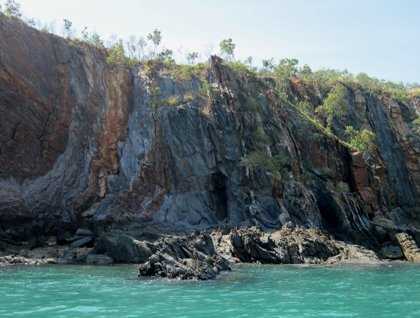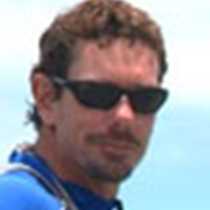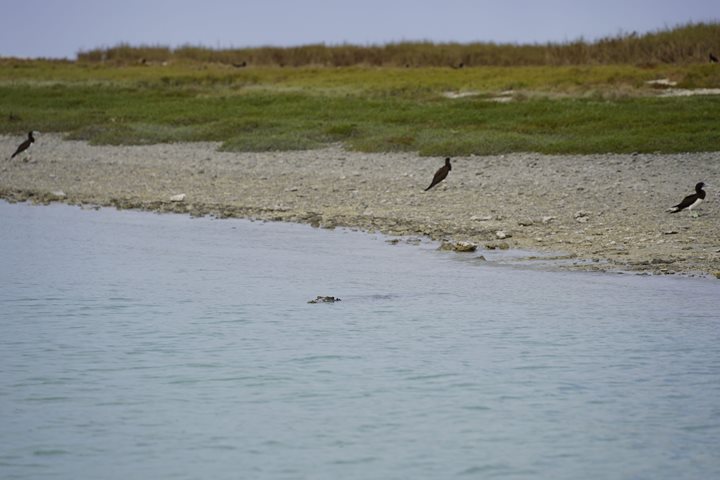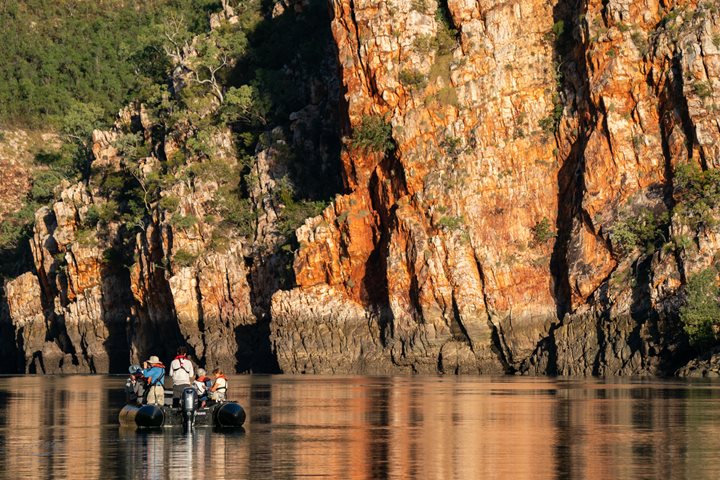Today is our last day on board National Geographic Orion, but there is still great excitement and anticipation as we approach the mineral-rich southeast Kimberley region of northwestern Australia. So what’s in store for us today? How can all the things we have done in the last nine days be bettered; or can it? What is the only thing that we have not done yet? How about a swim – we have yet to swim in these warm tropical waters. So during the cool of the morning a surprise awaits, with a visit to a hidden oasis called Crocodile Creek, tucked away at the far end of narrow bay, lined with colorful orange cliffs of sandstone and mangrove trees. A spectacular waterfall forms the backdrop for an inviting swimming hole that, thankfully, belies its name. The only crocs here today are of the inflatable pool toy variety. What a way to spend our last day, swimming in the crystal clear waters in the heart of the Kimberley.
The swimming hole itself has a mixture of fresh and salt water in it, but the water is layered, which means that because salt water is heavier than fresh, the salt water which comes up into the water hole from the large tide lays at the bottom, and the fresh water that comes down from the waterfall lays on the top, so you get fresh water species of fish swimming on the top layer and saltwater species of fish swimming on the bottom, which also includes jellyfish. After a relaxing swim, we make our way back to the ship for a well-earned lunch and maybe a cheeky beer or two.
Looking back at the morning, the most amazing thing about the location is the tidal range, which today is over 10 meters (30 feet) between the high and low extremes. When we arrive near the high tide it’s easy to step on shore to visit the waterfall. But by the time we embarked the last Zodiac shuttle back to the ship, we must climb down rock steps to the boats waiting far below. Impressive indeed.
We begin our explorations in the afternoon after a hearty lunch served in the outdoor café on the aft deck. The Zodiacs follow the rocky coastline in Yampi Sound, darting in and out of small bays. To our surprise, the rock layers are wildly twisted and contorted into great folds called anticlines and synclines. We learn that the sandstones were deposited in an ancient sea nearly two billion years ago and were later deformed during plate tectonic movements that assembled Australia’s basement rocks that we see today. This geologically significant area is also rich in minerals, with vast open-pit mines still active today that have yielded more than 100 million tons of iron ore over the decades.
The late afternoon Zodiac cruise marvels us all, not only at the spectacular rock formations, but also at the extreme low tide that exposes the intertidal zone covered with algae and oysters. Following our foray, we all are back on board in time to enjoy the sunset and moonrise from the deck of the ship. After a quick shower its off to the main lounge for a viewing off the documentary-style movie of our entire voyage; it’s amazing to think that we were able to fit so much into our ten-day adventure!
The captain’s farewell cocktail reception follows with a ceremonial clinking of glasses. The voyage is officially over as we lift anchor and sail towards Broome. Thank you, National Geographic Orion, for a fantastic journey.







